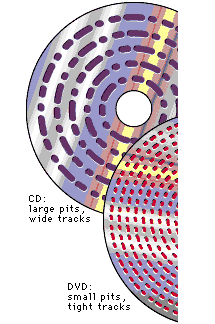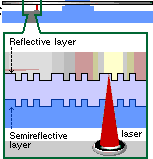
DVD vs CD-ROM Pit Length

DVD layers
There are many variations on the DVD theme. There are two physical sizes: 12 cm (4.7 inches) and 8 cm (3.1 inches), both 1.2 mm thick. These are the same form factors as CD. A DVD disc can be single-sided or double-sided. Each side can have one or two layers of data. The amount of video a disc can hold depends on how much audio accompanies it and how heavily the video and audio are compressed. The oft-quoted figure of 133 minutes is apocryphal: a DVD with only one audio track easily holds over 160 minutes, and a single layer can actually hold up to 9 hours of video and audio if it's compressed to VHS quality.
At a rough average rate of 4.7 Mbps (3.5 Mbps for video, 1.2 Mbps for three 5.1-channel soundtracks), a single-layer DVD holds around 135 minutes. A two-hour movie with three soundtracks can average 5.2 Mbps. A dual-layer disc can hold a two-hour movie at an average of 9.5 Mbps (very close to the 10.08 Mbps limit).
Capacities of DVD:
For reference, a CD-ROM holds about 650 MB (megabytes), which is 0.64 GB (gigabytes) or 0.68 G bytes (billion bytes). In the list below, SS/DS means single-/double-sided, SL/DL means single-/dual-layer, GB means gigabytes (230), G means billions of bytes (109).
DVD-5 (12cm, SS/SL): 4.38 GB (4.7 G) of data, over 2 hours of video DVD-9(12cm, SS/DL): 7.95 GB (8.5 G), about 4 hours DVD-10 (12cm, DS/SL): 8.75 GB (9.4 G), about 4.5 hours DVD-18 (12cm, DS/DL): 15.90 GB (17 G), over 8 hours DVD-1? (8cm, SS/SL): 1.36 (1.4 G), about half an hour DVD-2? (8cm, SS/DL): 2.48 GB (2.7 G), about 1.3 hours DVD-3? (8cm, DS/SL): 2.72 GB (2.9 G), about 1.4 hours DVD-4? (8cm, DS/DL): 4.95 GB (5.3 G), about 2.5 hours DVD-R (12cm, SS/SL): 3.68 GB (3.95 G) DVD-R (12cm, DS/SL): 7.38 GB (7.9 G) DVD-R (8cm, SS/SL): 1.15 GB (1.23 G) DVD-R (8cm, DS/SL): 2.29 GB (2.46 G) DVD-RAM (12cm, SS/SL): 2.40 GB (2.58 G) DVD-RAM (12cm, DS/SL): 4.80 GB (5.16 G)
Note: It takes about two gigabytes to store one hour of average video (Chapter 6).
The increase in capacity from CD-ROM is due to:

DVD vs CD-ROM Pit Length

DVD layers
The capacity of a dual-layer disc is slightly less than double that of a single-layer disc. The laser has to read through the outer layer to the inner layer (a distance of 20 to 70 microns). To reduce inter-layer crosstalk, the minimum pit length of both layers is increased from .4 um to .44 um. In addition, the reference scanning velocity is slightly faster - 3.84 m/s, as opposed to 3.49 m/s for single layer discs. Bigger pits, spaced farther apart, are easier to read correctly and are less susceptible to jitter. Bigger pits and fewer of them mean reduced capacity per layer.